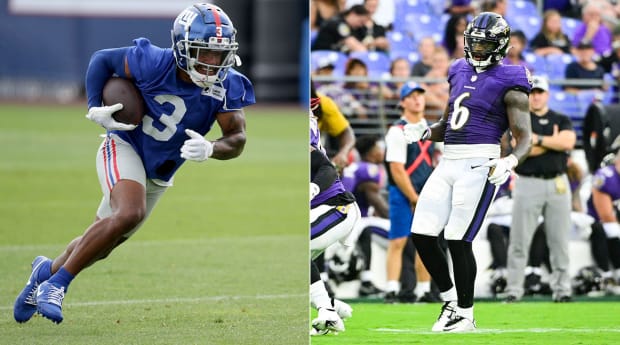Players like Sterling Shepard and Patrick Queen shared their reasons for making the switch once the rule was loosened.
Patrick Queen charged toward Saints quarterback Taysom Hill, diving at his opponent’s legs and
forcing him to the ground for a loss of 12 yards. The Ravens linebacker stayed down for a moment, kneeling on the ground and flexing while a teammate came over and gave him a few taps on the helmet as the crowd at M&T Bank Stadium cheered.The play didn’t just force a fourth down in an August preseason game; it also gave fans a glimpse of something the NFL had never seen before: a sack by a player wearing a single-digit jersey number.
Since the league imposed a stricter system in 1973 (before sacks were official), only quarterbacks, kickers and punters could don single-digit numbers. But, in April, the longstanding restrictions changed when NFL owners accepted a proposal from the Chiefs.
Players across the league, like Queen, quickly took advantage of the opportunity. Though, in order to do so, each one (unless they changed teams over the offseason) had to buy out the remaining inventory of unsold jerseys with their former number, which could be a hefty price in some cases.
Here are some of the best stories behind number switch-ups around the league.

Kevin R. Wexler/NorthJersey.com/USA TODAY Network (Shepard); Tommy Gilligan/USA TODAY Sports (Queen)
Sterling Shepard, WR, Giants: switched from 87 to 3
Shepard has tried to honor his father, who died when he was 6 years old, throughout his football career. When he first entered the league as a second-round pick for the Giants in 2016, Shepard chose No. 87, one of the six numbers Derrick Shepard wore throughout his time in the NFL as a wide receiver for Washington, the Cowboys and the Saints from 1987 to ’91.
Though 87 carried a special meaning in that regard, three is the number Shepard really associates with his father.
That’s what his father wore at Oklahoma, where he went from walk-on to starting wide receiver for the 1985 national championship team. Three is the number that was on the helmet the Sooners sent Shepard following the fatal heart attack in ’99, telling the young boy he’d one day follow in the footsteps of his father (who also coached there for a brief period) and uncles. Three is the number he wore from that point forward, whenever he had the choice at least, from Pop Warner through his own playing days as a Sooner.
So, when he heard that the rule was changing back in April, Shepard wanted to make the switch right away.
“It's something I've always wanted to do, and it feels good just to be able to honor him in that way—wearing the number three and having the Shepard on the back of my jersey,” he said. “And I'm sure that he would be proud of me as far as I’ve come so far.”
Budda Baker, S, Cardinals: switched from 32 to 3
As soon as the number rule change was announced, Baker knew he wanted to switch as well.
The option to be one of the first safeties wearing single digits in the NFL was appealing in itself, but even more so was the chance to wear No. 3.
“I take numbers very serious,” Baker said in his first media availability of the offseason.
His love of the number three comes from growing up as a huge Allen Iverson fan. He was enamored by the way the Philadelphia 76ers guard changed basketball with his unique “swag” on and off the court, and he also admired Iverson’s effort, which he tries to emulate on the football field. It felt like a natural fit.
Unlike many players who changed their numbers this offseason, Baker never wore three during his college playing days at Washington, or even in high school. But now emulating the 11-time All-Star, the safety looks to continue his success in the league, aiming to turn his three Pro Bowl appearances in four years into a legacy for his franchise.
“Hopefully that number never gets worn again for the Cardinals,” Baker said.
Julio Jones, WR, Titans: switched from 11 to 2
For the first time since he entered the league in 2011, Jones will be playing for a new franchise and with a new number, trading in No. 11 on the Falcons for No. 2 on the Titans.
The seven-time Pro Bowl selection was at dinner with new teammates, wide receiver A.J. Brown and quarterback Ryan Tannehill, shortly after he joined Tennessee when Brown offered to give him the signature number. But Jones declined.
“I was like, ‘Bro, I don’t want it. That’s your number,’ ” Jones recalled in his introductory press conference.
Jones opted to go with No. 2 instead. The number didn’t hold a previous meaning for him, but it is symbolic.
“One plus one is two, then two times 11 is 22, so, it’s kind of like … you’re gonna have to deal with us,” Jones said.
Brown, the Titans’ top receiver, is No. 11, and star running back Derrick Henry has worn No. 22 throughout his time in the league. Though Tannehill couldn’t fit into the math equation, Jones said the message speaks to him and the entire 11-man offense as well.
“It’s just something just to keep the guys going and just have fun with it,” Jones said. “Because at the end of the day it’s our job, but we want to have fun with it.”
Patrick Queen, LB, Ravens: switched from 48 to 6
Queen had his eye on No. 8, which he wore at LSU en route to the 2020 national championship, once the rule change was announced. But, of course, that number was occupied by none other than his quarterback, ’19 NFL MVP Lamar Jackson.
Queen tried to negotiate his way toward a bargain with Jackson on Twitter, to no avail, later tweeting it was a joke. But Queen still wanted to take advantage of the new rule entering his second year in the league.
“It was just the right thing to do,” Queen said during his first media availability of the offseason. “Single-digit swag, just the swagger that comes with it, just the feel that comes with it.”
When you see Queen making plays for the Ravens this season, building off a Defensive Rookie of the Year campaign last year, he’ll be wearing No. 6 as a nod to his hometown of Ventress, La.
“Back home, the place that we from, we call it ‘Six,’ ” Queen said. “Just try to put the city on me, try to show ’em where I’m from.”
More NFL Coverage:
• Tom Brady's Forgotten Rookie Year
• Predicting Every Game of the 2021 Season
• How Derrick Henry Handles a Throwback Workload
• An Early Look at the 2022 NFL Quarterback Carousel

0 Comments:
Post a Comment